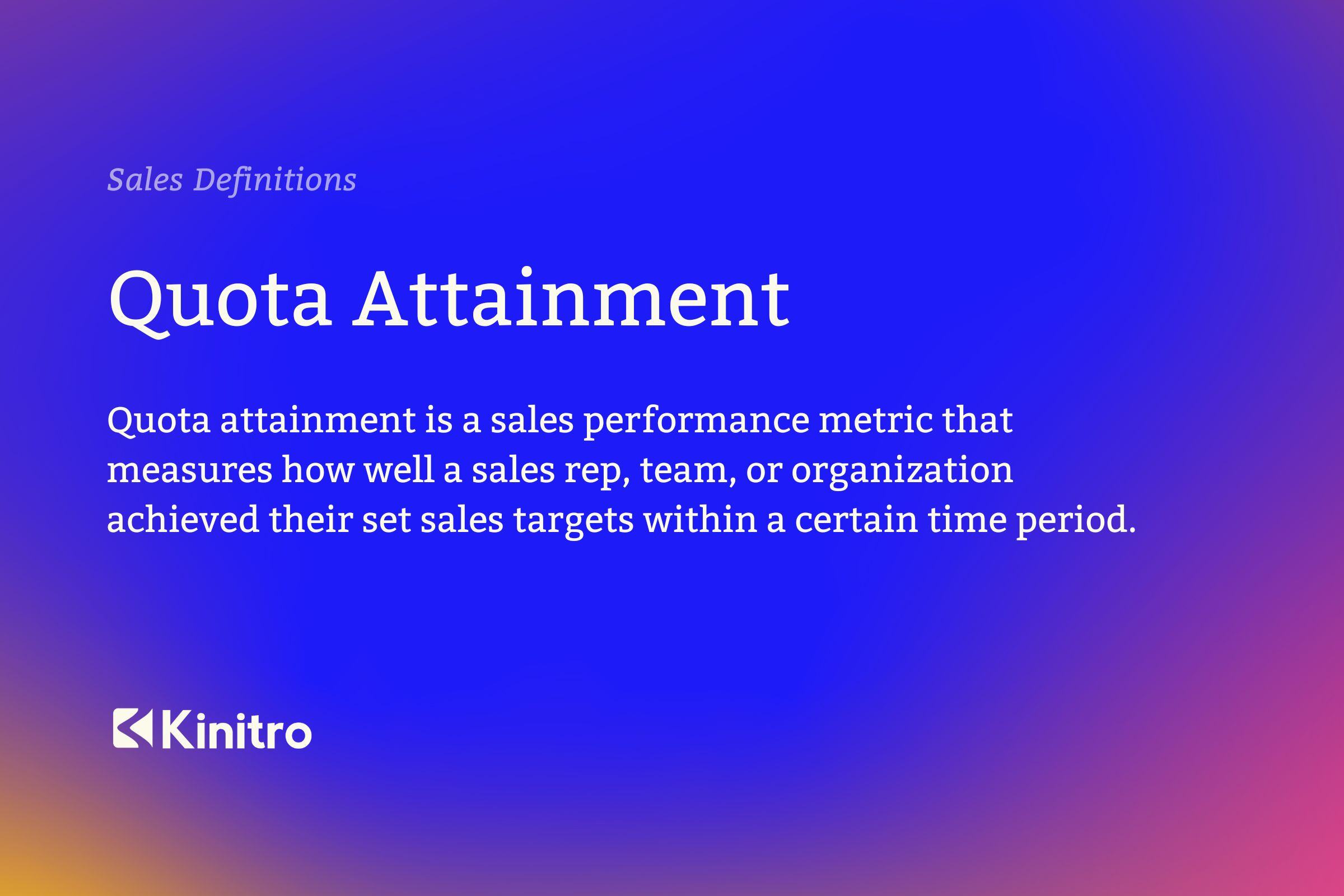In this blog post, readers will dive into the world of sales quota attainment and learn valuable strategies for maximizing success in their sales organizations.
From decoding sales quota attainment to crafting a winning formula, this post offers insights into setting realistic quotas, providing essential support and resources, and leveraging sales enablement tools for improved performance and growth.
Readers will gain a comprehensive understanding of how to set achievable sales quotas, enhance sales rep performance, and incentivize with a flexible compensation plan to drive superior sales success.
Key Takeaways
-
Decode sales quota attainment to maximize success.
-
Craft a winning formula that takes into account market conditions and individual rep capabilities.
-
Utilize strategies such as setting realistic quotas, providing support & resources, and leveraging sales enablement tools for improved performance & growth.
Decoding Sales Quota Attainment
Sales quota attainment serves as a critical measure for assessing sales rep performance, projecting revenue growth, and aligning personal goals with organizational objectives.
A well-planned sales quota agreement ensures that the entire sales organization is working together to meet common objectives.
Sales managers, through close observation of attainment rates, can modify quotas in response to market dynamics, which keeps the sales team flexible and goal-oriented.
To calculate quota attainment, a specific formula considering sales targets, actual sales, and attainment rates is used. This accurately measures if a rep has fulfilled, surpassed, or failed to meet their quota.

Crafting a Winning Sales Quota Formula
A meticulously developed sales quota formula is crucial for setting reachable targets for your sales team. It should take into account factors such as historical sales data, market conditions, and individual rep capabilities to ensure a fair sales quota agreement.
Sales leaders can choose from various types of sales quotas, such as revenue, profit, volume, or activity quotas, depending on the company’s objectives. A combination sales quota, for example, is composed of several activity quotas and a profit quota, designed to help sales reps achieve their sales target.
Employing the appropriate sales quota formula and considering the specific factors impacting your sales organization enables the creation of a customized approach that paves the way for your team’s success.
The Art of Setting Achievable Sales Quotas
Setting achievable sales quotas is an intricate balance of identifying individual rep goals, aligning team objectives with business goals, and adjusting quotas for market dynamics.
The upcoming sections will examine each of these elements to assist in developing a quota-setting process that promotes success and fully exploits your team’s potential.
Identifying Individual Rep Goals
Individual rep goals should be based on their skills, experience, and past performance to ensure realistic expectations. This involves evaluating sales metrics such as:
-
Revenue generated
-
Number of deals closed
-
Average order value
-
Conversion rates
These metrics can provide insights into the rep’s performance and help establish attainable goals.
When setting individual goals, it is also essential to consider market conditions, the competitive landscape, and the rep’s strengths and weaknesses.
Adjusting quotas to the unique abilities of each sales rep fosters a motivational environment where reps feel challenged yet not overloaded, leading to improved quota fulfillment and superior sales performance.
Aligning Team Objectives with Business Goals
Aligning team objectives with business goals is a vital aspect of setting achievable sales quotas. This ensures that sales quotas contribute to the overall success of the company and prevents misalignment between sales activities and the larger company objectives.
Alignment of team objectives with business goals in sales requires the following steps:
-
Establish a clear North Star goal
-
Reach consensus on shared targets and objectives
-
Identify key performance indicators (KPIs)
-
Develop relevant content and strategies
-
Promote collaboration and communication
By keeping the team’s objectives in sync with business goals, you ensure a unified approach to sales success and maximize revenue generation.
Adjusting Quotas for Market Dynamics
Adjusting quotas for market dynamics is a crucial aspect of setting achievable sales quotas. This involves taking into account factors such as seasonality, competition, and economic trends, which can significantly impact sales performance.
For example, seasonality can lead to fluctuations in sales revenue that are determined by external factors occurring on a predictable timeline. Adjusting quotas to accommodate these seasonal variations ensures that realistic and achievable targets are set.
Likewise, considering competition and economic trends can also help in setting quotas that accurately reflect the realities of the market.
Adjusting quotas in response to market dynamics guarantees that your sales team stays flexible and adaptable amid constantly shifting conditions.
Enhancing Sales Rep Performance for Better Quota Attainment
Enhancing sales rep performance is a multifaceted approach that involves empowering reps with sales training, streamlining the sales process, and leveraging sales enablement tools.
The forthcoming three sections will examine each of these strategies in detail, concentrating on their contribution to improved quota fulfillment and comprehensive sales success.
Empowering Reps with Sales Training
Sales training programs play a vital role in equipping sales representatives with the necessary skills and knowledge to effectively sell products and services. Providing appropriate training and coaching guarantees that your sales reps are ready to confront the challenges of meeting and surpassing their sales targets.
A successful sales training program should include:
-
Skills assessments
-
Key business success measures
-
Support from senior management
-
Ongoing coaching and advisement with sales leadership
-
Essential skills assessment
-
Sales processes and product training
-
Customer buying experience
By investing in continuous sales training, you set your team up for success and create a culture of learning and growth that drives better quota attainment.
Streamlining the Sales Process
Streamlining the sales process involves automating repetitive tasks and simplifying workflows to save time and increase efficiency. Optimizing the sales process allows sales reps to concentrate more on customer interaction activities and deal closures, leading to improved quota attainment in the end.
Key steps in the sales process that can be streamlined include:
-
Optimizing the sales process itself
-
Analyzing and refining buyer personas
-
Incorporating ‘Big Data’ technologies
-
Leveraging social platforms to attract and engage potential customers
-
Applying effective closing techniques
By streamlining the sales process, you empower your sales team to work smarter, not harder, ultimately driving better sales performance and quota attainment.
Leveraging Sales Enablement Tools
Sales enablement tools, such as CRM systems and content libraries, provide reps with the resources they need to close deals more effectively. These tools not only assist with organizing and managing customer data but also offer valuable insights that can help optimize sales strategies and monitor sales trends.
Successful sales teams typically utilize the following tools as their primary sales enablement tools:
-
Ambition
-
Salesloft
-
Brainshark
-
Showpad Content
-
CRM systems
Supplying your sales team with appropriate tools and resources allows them to work more efficiently and effectively, leading to superior quota attainment and comprehensive sales success in the end.

Incentivizing with a Flexible Compensation Plan
A flexible sales compensation plan plays a vital role in incentivizing sales reps by offering rewards and bonuses based on their performance and quota attainment. This guarantees that your sales team stays motivated and driven to reach their targets, contributing to the overall success of the company in the end.
An effective flexible compensation plan should encompass:
-
A well-considered structure with the appropriate balance of salary, commission, bonus, and incentives
-
Eligibility requirements
-
Pay mix and leverage
-
Performance evaluation
-
Quota establishment
By offering a well-designed and motivating compensation plan, you inspire your sales team to strive for excellence and surpass their sales goals.
Tracking and Analyzing Sales Performance Data
Tracking and analyzing sales performance data is essential for identifying trends, monitoring attainment rates, and adapting strategies based on insights.
The upcoming sections will examine the benefits of keeping a close eye on attainment rates, using sales analytics for growth, and modifying strategies based on insights.
Monitoring Attainment Rates
Monitoring attainment rates allows for the identification of top performers and areas for improvement. By keeping a close eye on attainment rates, sales managers can provide timely feedback and coaching, helping sales reps enhance their performance and achieve their quotas.
Utilizing Sales Analytics for Growth
Utilizing sales analytics for growth involves leveraging data to make informed decisions and optimize sales strategies. By analyzing sales performance data, sales managers can gain valuable insights to help them recognize patterns and trends, optimize sales processes, and estimate future sales growth.
Some of the most effective sales analytics tools for growth include:
These tools provide invaluable insights to optimize sales strategies and monitor sales trends.
Utilizing sales analytics enables your sales team to stay ahead and make decisions based on data, promoting growth.
Adapting Strategies Based on Insights
Adapting strategies based on insights ensures that sales teams are constantly evolving and improving their performance. By evaluating the data gathered from sales analytics, sales managers can identify areas of improvement and adjust their strategies accordingly.
Some strategies for optimizing sales performance insights include:
-
Hiring suitable personnel
-
Investing in sales enablement
-
Utilizing an effective sales structure
-
Revising the sales strategy
-
Regularly refining strategies based on trends, market modifications, and customer feedback.
Constantly modifying strategies based on insights keeps your sales team flexible, ready to confront challenges, and poised for success.
Overcoming Common Quota Attainment Challenges
Overcoming prevalent quota attainment challenges is critical to sustain a high-performing sales team. In the following subsections, we will discuss the importance of avoiding unrealistic quota setting and managing stress and burnout among sales reps.
Avoiding Unrealistic Quota Setting
Unrealistic quota setting can demotivate sales reps and hinder performance. Quotas should be based on realistic expectations and individual capabilities to ensure that sales reps remain motivated and committed to achieving their targets.
To determine realistic sales quotas, sales managers should:
-
Evaluate historical sales data
-
Consider market trends
-
Evaluate product offerings
-
Set achievable goals
-
Utilize CRM data for insights into individual performance
Establishing realistic and achievable quotas allows a sales manager to foster a motivational environment that promotes sales success and exceeds revenue targets for their sales managers.
Managing Stress and Burnout
Managing stress and burnout among sales reps is essential for maintaining a healthy work-life balance and improving performance. Providing support and resources to help sales reps cope with the pressures of meeting quotas can significantly impact their overall well-being and success.
Some strategies to maintain work-life balance in high-pressure sales environments include:
-
Simplifying the work environment
-
Prioritizing tasks
-
Creating a schedule
-
Setting boundaries
-
Carving out time for personal activities
-
Managing time effectively
Proactively tackling stress and burnout enables sales managers to ensure their team stays focused, motivated, and ready for success.
Summary
In summary, maximizing quota attainment is essential for driving sales success and surpassing revenue goals. By crafting a winning sales quota formula, setting achievable sales quotas, enhancing sales rep performance, incentivizing with a flexible compensation plan, and tracking and analyzing sales performance data, you can create a high-performing sales team that consistently exceeds expectations.
Remember, the key to surpassing sales goals lies in continuous improvement, data-driven decision-making, and a motivated sales team. With the right strategies in place, you can unlock the full potential of your sales organization and achieve unprecedented levels of success.
Frequently Asked Questions
What is quota attainment?
Quota attainment is a sales performance metric that measures how well a sales rep, team, or organization achieved their set sales targets within a certain time period. It’s expressed as a percentage of total quota achieved and provides insight into the reality of on-target earnings.
What is a good average quota attainment?
Achieving 80% quota attainment is an indication of your team’s performance and sales process running smoothly. This is a great sign that your team feels motivated to succeed and is hitting its quotas consistently.
How do you calculate sales attainment?
Sales attainment is calculated by dividing the actual sales amount by the total sales quota, then multiplying that by 100 and showing it as a percentage. For example, if a sales rep had a quota of $250,000 and achieved $235,000 in actual bookings, their sales attainment would be 94%.
What factors should be considered when setting individual sales rep goals?
When setting individual sales rep goals, it is important to consider each rep’s skillset, past performance, market conditions, and territory/account potential in order to set realistic expectations.







